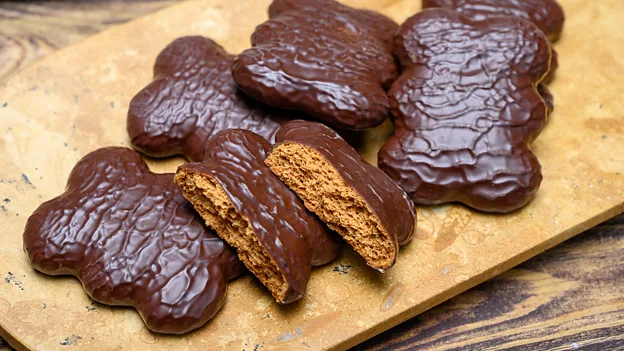Post by Jaga on Dec 4, 2023 4:58:36 GMT -7
with pictures, famous pierniki
www.bbc.com/travel/article/20231130-katarzynki-polands-famous-gingerbread-from-toru
Although the recipe is usually kept secret, Ren Behan, author of Sweet Polish Kitchen, has found a way to make Polish gingerbread biscuits from the town of Torun at home.

The Polish city of Toruń is famous for being the birthplace of Nikolaus Copernicus – also known as Kopernik – the astronomer who, as we say in Poland, "stopped the Sun, and moved the Earth". But Kopernik is also the name of a company producing the town's famous Toruńskie pierniczki (Toruń gingerbread), which is celebrating its 260th anniversary this year.
Many Polish sweets are named after people (a chocolate bar called Grzesiek, or Greg, is a great example), and a type of Toruń gingerbread called katarzynki is no exception. These spiced biscuits, which are covered in chocolate and shaped like a cloud, were most likely named after Katherine of Alexandria, a 4th-Century saint and martyr who is honoured in the Orthodox and Catholic church on 25 November. In Poland, "Katarzynki Day" is often celebrated by young men who wish to get married and is devoted to fortune telling and divination rituals to reveal the name of their future wives. (Women have "Andrzejki Day", or St Andrew's Day, on 30 November.)
[jump to recipe]
25 November is the day Toruń bakers typically start preparing the dough for the Christmas biscuits. The ingredients include honey, sugar, flour, egg and spices like cinnamon, cloves and allspice; not necessarily ginger. While these treats have "ginger" in their English name, their Polish name, pierniczki, stems from pierny, an old Polish word meaning "peppery".
According to the Gingerbread Museum in Toruń, gingerbread dates to as early as 1380. A predecessor of pierniczki was already produced in the Roman Empire and then spread to other places in Europe – including The Netherlands, Germany and the Czech Republic – during Medieval times. Toruń became famous for its gingerbread, originally brought to the city by Germans, due to its location at the crossing point of various European trading routes and its membership in the Hanseatic League, which introduced the city to the spices.

Wedding gingerbread
Pierniczki (gingerbread) dough used to be prepared in families when a baby girl was born. It would mature for years before being rolled out, cut and baked on her wedding day.
The diminutive form separates pierniczki (gingerbread biscuits) from piernik (gingerbread cake). But according to writer and cookbook author Ren Behan, katarzynki tend to be something in between the two, texture-wise: "It's really about wanting something that's not quite a biscuit and not quite cake, but something in the middle that has some softness in it," she said.
Behan was born in the UK to Polish parents and feels very grounded in Polish culture. "It's one of the things I used to eat as a child when we would go to the Polish Combatants' Club [Polski Dom Kombatanta w in Manchester]. Behind the bar they always had packets of katarzynki. I very much remember the noise that the packet made and sinking my teeth into that first chocolate and then that lovely gingerbread," she said.
The recipe for Toruń gingerbread was often only passed down orally. Kopernik, the largest and most famous producer of Toruń gingerbread keeps their recipe a carefully guarded secret. They have registered the name "katarzynki" to refer to their cloud-shaped version. However, Behan has found a way to make katarzynki at home.
"You've got runny honey, sugar, butter. I use rye flour, cinnamon, cloves, allspice, and then a little bit of cocoa powder just for the flavour, and that nice darkness when it bakes. And then just good quality chocolate poured over the top."
Behan had the typical cloud-shaped biscuit cutter shipped over from Poland. But home chefs aiming for the traditional look should not despair if they don't have one.
www.bbc.com/travel/article/20231130-katarzynki-polands-famous-gingerbread-from-toru
Although the recipe is usually kept secret, Ren Behan, author of Sweet Polish Kitchen, has found a way to make Polish gingerbread biscuits from the town of Torun at home.

The Polish city of Toruń is famous for being the birthplace of Nikolaus Copernicus – also known as Kopernik – the astronomer who, as we say in Poland, "stopped the Sun, and moved the Earth". But Kopernik is also the name of a company producing the town's famous Toruńskie pierniczki (Toruń gingerbread), which is celebrating its 260th anniversary this year.
Many Polish sweets are named after people (a chocolate bar called Grzesiek, or Greg, is a great example), and a type of Toruń gingerbread called katarzynki is no exception. These spiced biscuits, which are covered in chocolate and shaped like a cloud, were most likely named after Katherine of Alexandria, a 4th-Century saint and martyr who is honoured in the Orthodox and Catholic church on 25 November. In Poland, "Katarzynki Day" is often celebrated by young men who wish to get married and is devoted to fortune telling and divination rituals to reveal the name of their future wives. (Women have "Andrzejki Day", or St Andrew's Day, on 30 November.)
[jump to recipe]
25 November is the day Toruń bakers typically start preparing the dough for the Christmas biscuits. The ingredients include honey, sugar, flour, egg and spices like cinnamon, cloves and allspice; not necessarily ginger. While these treats have "ginger" in their English name, their Polish name, pierniczki, stems from pierny, an old Polish word meaning "peppery".
According to the Gingerbread Museum in Toruń, gingerbread dates to as early as 1380. A predecessor of pierniczki was already produced in the Roman Empire and then spread to other places in Europe – including The Netherlands, Germany and the Czech Republic – during Medieval times. Toruń became famous for its gingerbread, originally brought to the city by Germans, due to its location at the crossing point of various European trading routes and its membership in the Hanseatic League, which introduced the city to the spices.

Wedding gingerbread
Pierniczki (gingerbread) dough used to be prepared in families when a baby girl was born. It would mature for years before being rolled out, cut and baked on her wedding day.
The diminutive form separates pierniczki (gingerbread biscuits) from piernik (gingerbread cake). But according to writer and cookbook author Ren Behan, katarzynki tend to be something in between the two, texture-wise: "It's really about wanting something that's not quite a biscuit and not quite cake, but something in the middle that has some softness in it," she said.
Behan was born in the UK to Polish parents and feels very grounded in Polish culture. "It's one of the things I used to eat as a child when we would go to the Polish Combatants' Club [Polski Dom Kombatanta w in Manchester]. Behind the bar they always had packets of katarzynki. I very much remember the noise that the packet made and sinking my teeth into that first chocolate and then that lovely gingerbread," she said.
The recipe for Toruń gingerbread was often only passed down orally. Kopernik, the largest and most famous producer of Toruń gingerbread keeps their recipe a carefully guarded secret. They have registered the name "katarzynki" to refer to their cloud-shaped version. However, Behan has found a way to make katarzynki at home.
"You've got runny honey, sugar, butter. I use rye flour, cinnamon, cloves, allspice, and then a little bit of cocoa powder just for the flavour, and that nice darkness when it bakes. And then just good quality chocolate poured over the top."
Behan had the typical cloud-shaped biscuit cutter shipped over from Poland. But home chefs aiming for the traditional look should not despair if they don't have one.


